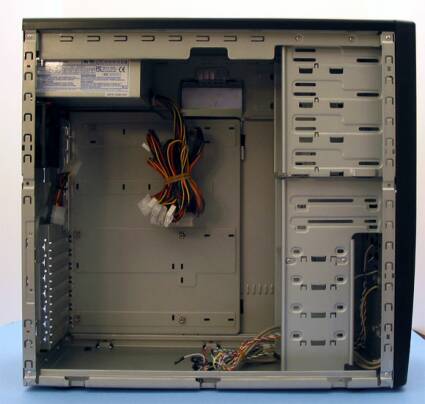2003 Winter Case Review Part 2: The ATX Avalanche
Jeantech Butterfly Series 2011, Continued
The Butterfly Series 2011 earns our award in this review for having one of the most interesting names. The 2011 is named "butterfly" for the unique way that the two handles pull up from the two side panels on each side of the case, and the side panels disembark from the case similarly to the way a butterfly moves its wings. This is a very unique departure from other cases previously reviewed. The quality of the case construction itself is very good.
While the 2011 does not rival some of the high-end cases that we have covered in this review, it certainly offers construction and design that is far above the average quality found in many other cases. Another unique feature of the 2011 is the manner in which the motherboard tray from within the case. Unlike other models that feature a slide-out motherboard tray, due to the butterfly design of the 2011, the normally unused right side panel folds down for easy access to the motherboard tray directly mounted to the side panel. This arrangement certainly takes up significantly more space than a pullout motherboard tray, but it does provide easier access to the motherboard and components than are often found in cases with slide-out motherboard trays. Jeantech definitely earns significant kudos for this innovative design. Still, in order to pull down this motherboard tray that is incorporated into the side panel will require approximately 26 inches of clearance, including the space for the case itself. Those wanting to work on this case in tight quarters need to allow sufficient room to be able to gain access. An important thing to remember is to disconnect the three-pin fan from its connector on the motherboard prior to releasing the right hand side panel to gain access to the motherboard, or you may bend the motherboard pins.
A look inside of the 2011.
The construction of the 2011 overall is quite good. Using a stamp sheet metal process with rolled edges with riveting to hold the case together, the 2011 exhibited some bend and some twist; but overall it is a very sturdy specimen during our testing of it. The cooling configuration of the 2011 consists of two 80mm fans in the front of the case and a single 80mm fan in the rear of the case. Jeantech did not include the two front-mounted 80mm fans for our testing, which was somewhat unusual as airflow through the case was greatly inhibited without use of these two front-mounted fans. To future complicate matters, Jeantech utilizes a very small sculpted intake underneath the USB/MIC/headphone ports door for air to enter the front of the case. We were not overly impressed with the size of this air intake, as it restricted airflow to the rear of the 2011. We would suggest that Jeantech attempt to rework the front of the bezel airflow path to provide better air intake for the 2011.
The cooling performance of the 2011 was not stellar, but it was certainly acceptable during our testing. We would not recommend this case for overclockers, but for most normal applications the cooling setup should be quite sufficient.
Get Tom's Hardware's best news and in-depth reviews, straight to your inbox.
Current page: Jeantech Butterfly Series 2011, Continued
Prev Page Jeantech Butterfly Series 2011 Next Page Jeantech Butterfly Series 2011, Continued